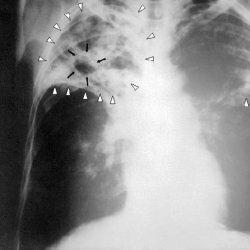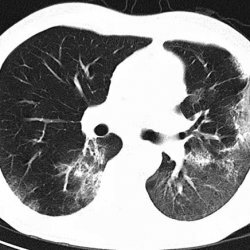Cirrhotic pulmonary tuberculosis
 Cirrhotic tuberculosis of the lungs is a disease related to inactive forms of tuberculosis, with fibrotic changes in the lungs being pronounced. This form of tuberculosis is the final stage of tuberculosis of the lungs. Easily destroyed due to an increased respiration rate exceeding the body's need for oxygen, combined with inflammatory changes tuberculosis or tubercular character or as a consequence of tubercular lesions of total lung with secondary fibrosis. Often
Cirrhotic tuberculosis of the lungs is a disease related to inactive forms of tuberculosis, with fibrotic changes in the lungs being pronounced. This form of tuberculosis is the final stage of tuberculosis of the lungs. Easily destroyed due to an increased respiration rate exceeding the body's need for oxygen, combined with inflammatory changes tuberculosis or tubercular character or as a consequence of tubercular lesions of total lung with secondary fibrosis. Often
cirrhotic tuberculosis is the result of the equity process( caseous pneumonia, finished off), serous and purulent pleurisy or surgery( extrapleural pnevmoliz, thoracoplasty).
cirrhotic lung tissue exposed to the development of bronchiectasis, which are often joined by lung and heart failure, the displacement of the trachea, heart and great vessels. Bacterial tuberculosis is practically not secreted or is detected periodically, mainly during the sowing of excretions from the bronchi.
In lung lesions with cirrhotic tuberculosis, patients experience shortness of breath, cough and, in some cases, hemoptysis. Sometimes cirrhotic lung injury is complicated by pneumonia of a non-specific nature.
Cirrhotic pulmonary tuberculosis:
symptoms The most characteristic symptoms of cirrhotic tuberculosis are progressing over time shortness of breath and cough with sputum. At the onset of the disease, shortness of breath appears after physical exertion, as the disease develops, shortness of breath appears and at rest. When rupture of blood vessels there are hemoptysis and pulmonary hemorrhage. Body temperature with cirrhotic tuberculosis is increased due to exacerbation of chronic pneumonia or bronchoectatic disease.
Cirrhotic tuberculosis on severity of the disease can be divided into five types:
- Reserved form cirrhotic tuberculosis with implicit manifestation of symptoms and characterized by limited variation lobar or segmental type which is formed due to the transferred atelectasis or infiltrative tuberculosis in combination with the scar changes bronchi, bronchiolitis or endobronchitis. In addition to cicatrical changes in the affected area, tuberculomas, tuberculosis foci or residual caverns may be present. During the examination, hard breathing and wet wheezing are often detected. Rare exacerbations are manifested by a slight increase in body temperature, sputum and cough. Occasionally, bleeding may occur.
- Limited cirrhotic tuberculosis, characterized by frequent exacerbations that result from the defeat of tuberculosis infection or secondary mixed flora. Exacerbations occur periodically at various intervals. Depending on the stage of development of the disease, exacerbations may be more or less prolonged, and the intervals increase or decrease. At an exacerbation the body temperature rises to thirty eight and more degrees, there is a night sweating, a leukocytosis, delicacy. Of chest symptoms, you can identify shortness of breath, cough and sputum. Dry and wet wheezing is heard in the lungs. In the interval between exacerbations, symptoms decrease or disappear.
- Cirrhotic tuberculosis with the appearance of bronchiectasis and systematic hemoptysis or pulmonary hemorrhage.
- Cirrhotic tuberculosis with the formation of "pulmonary heart" and various manifestations of pulmonary-cardiac and pulmonary insufficiency.
- "Destroyed" lung with a progressive tuberculosis process and various manifestations of metatuberculous syndrome.
Cirrhotic pulmonary tuberculosis: causes
emergence of tuberculosis acid-fast bacteria provoke sort Mycobacterium. These types of microbacteria are widespread in water, soil, among humans and animals. In humans, tuberculosis is caused by causative agents of human or bovine type, with reduced immunity, it is possible for the avian type of tuberculosis to be affected.
The development of cirrhotic tuberculosis requires a fairly long period, often lasting for years. But in some cases, the disease can develop rapidly. An equally important role is played by the age-related features of the organism. As a result of aging, the elastic fibers of the lung tissue change and replace them with a connective tissue, thereby forming emphysema. In the elderly, the most favorable conditions for the formation of fibro-sclerotic changes in the lungs are formed. But the development of cirrhotic tuberculosis affects people of middle, young and children.
In the development of cirrhotic tuberculosis, in addition to complications in the form of diseases of the cardiovascular system and the lungs, sclerosis can develop in the zone of tuberculous foci of a primary nature and in the lymph nodes. Often occurs the formation of fibrotic fields in the lungs, spleen, liver and other organs. In some cases, cirrhosis develops due to the defeat of lymph nodes as a result of the spread of the process to the walls of the bronchi with the formation of fistulas and ulcers on them.
A limited form of cirrhosis can develop as a result of focal pulmonary tuberculosis in the lesions of small bronchi and the disruption of normal operation of pulmonary ventilation. In addition to sclerosis, a clustered blister can form in the affected area.
Cirrhotic tuberculosis of the lungs is the final stage of long fibrous-cavernous pulmonary tuberculosis, for which the active growth of connective tissues is characteristic. Cirrhosis can be a consequence of a specific chronic pleurisy, especially purulent. It contributes to the development of pleurogenic cirrhotic tuberculosis and fibrotorax, as a result of which there is deformation of the chest, partial atrophy of the pectoral muscles, wrinkling of the intercostal spaces, displacement to the affected side of the heart, trachea and large vessels, a decrease in lung volume and a sharp restriction of their spread during respiration. Similar consequences occur most often with improper and untimely treatment of exudative pleurisy or empyema.
Complication in the form of cirrhotic tuberculosis can develop after surgery, for example, resection of the lung, if there is bronchial fistula and empyema of the pleura. The use of certain medications for too long a period contributes to the development of pneumosclerosis.
Cirrhotic tuberculosis of the lung: treatment and prevention
Three main tasks are distinguished in the treatment of cirrhotic tuberculosis:
- Treatment of a local process in the lungs directly.
- Elimination of bronchial obstruction or its reduction.
- Treatment of cardiac and pulmonary insufficiency.
Prevention of cirrhosis of the lungs is the timely and proper treatment of pulmonary tuberculosis in the early stages of its development and prevention of a variety of complications.



